
Decades after atmospheric nuclear testing ended, the effects of radiation exposure remain a cause for concern. This is especially true for those tied to areas like the Enewetak Atoll, a location heavily impacted by such testing.
As scientists continue to study its legacy, awareness grows around the health implications faced by “Downwinders,” atomic veterans, and others exposed to nuclear fallout.
In this blog, we will highlight essential facts to better understand Enewetak Atoll radiation and provide guidance for those seeking support or compensation.
What Happened at Enewetak Atoll?
Between 1946 and 1958, Enewetak Atoll became a critical site for atmospheric nuclear tests conducted by the United States. These were among the most powerful detonations in history. The immense forces released by these tests sent radioactive fallout into the atmosphere, a majority of which fell across downwind areas inhabited by unsuspecting populations.
Many who lived near these sites or participated in test operations, known as “atomic veterans,” suffered severe health consequences over the decades. The fallout from atmospheric nuclear tests spread radioactive particles far and wide, making exposure to radiation a persistent risk for both locals and military personnel stationed there.
Enewetak Atoll Radiation Facts to Remember
Below are some of the top facts to keep in mind regarding Enewetak Atoll radiation and its ongoing impact.
Fact 1: Radiation Fallout Was Widespread
Radioactive particles from the atmospheric nuclear tests conducted at Enewetak Atoll in the Pacific during the mid-20th century spread far beyond the immediate test sites. These particles contaminated surrounding islands, ocean waters, and even distant regions, impacting local populations, ecosystems, and food chains for decades.
The fallout has had long-term health consequences, including increased cancer risks, and environmental damage that persists to this day.
Fact 2: Health Effects of Enewetak Atoll Radiation Are Long-Term
Enewetak Atoll radiation has been linked to numerous health risks. People living in affected areas or atomic veterans exposed to radiation during testing programs often developed severe illnesses over time.
Below, we outline the critical health impacts associated with radiation from the Enewetak Atoll nuclear testing.
Thyroid Cancer Radiation Exposure
Thyroid cancer is one of the most common illnesses linked to exposure to nuclear test fallout. Radioactive iodine, a byproduct of nuclear detonations, accumulates in the thyroid gland.
Individuals exposed to Enewetak atoll radiation often unknowingly ingested radioactive particles through contaminated air, water, or food sources, which leads to cancer.
Other Cancers Linked to Radiation Exposure
Several other cancers have been linked to nuclear fallout, including, but not limited to:
- Lung cancer
- Leukemia
- Breast cancer
- Liver cancer
- Stomach cancer
These cancers could develop decades after the initial exposure, creating a long-term health crisis.
Risks to Future Generations
Studies suggest that Enewetak Atoll radiation exposure can lead to genetic mutations, increasing the risk of birth defects and illnesses in future generations of affected families. This intergenerational impact makes it crucial to understand and mitigate radiation risks.
Fact 3: Compensation for Radiation Exposure is Available
If you or a loved one has been exposed to radiation from Enewetak Atoll nuclear testing or other similar sites, you may be eligible for radiation-related compensation programs.
Many survivors may not even realize that federal benefit programs exist to help cover medical costs and provide financial support. You can get tax-free compensation if you qualify.
Who Qualifies for Compensation?
The people who qualify for compensation are as follows:
Atomic Veterans
Military personnel involved in nuclear testing, including those stationed near Enewetak Atoll, often qualify under radiation exposure policies.
Programs like atomic veteran compensation offer financial relief for illnesses caused by radiation exposure.
Downwinders
Individuals who lived downwind of nuclear test sites like Enewetak Atoll during specific periods (at least one year between January 21, 1951, and October 31, 1958, or throughout the entire month of July 1962) and developed cancer or other illnesses may be eligible for compensation.
How Do You File a Claim?
Filing a claim for cancer compensation, such as a VA cancer claim and Downwinders’ cancer compensation claim, involves detailed documentation of your diagnosis, residence history, and potential radiation exposure. Programs like the Radiation Exposure Compensation Act (RECA) have helped many individuals secure the support they deserve.
Organizations like the Cancer Benefits Center for Downwinders® offer resources and legal assistance to simplify the claims process. Our expertise ensures that qualified individuals receive the maximum compensation for radiation-related illnesses.
Get Compensation for Enewetak Atoll Radiation Exposure
If you are a Downwinder, atomic veteran, or family member dealing with the health effects of Enewetak Atoll radiation, the Cancer Benefits Center for Downwinders® can help. We offer expert guidance on filing cancer compensation claims and provide unparalleled support throughout this process.
Our services include:
- Assistance in determining eligibility for compensation
- Legal representation for filing claims
- Step-by-step guidance through complicated processes
Reach out to the Cancer Benefits Center for Downwinders® by filling out our registration form for expert assistance in filing your claim and securing the justice you deserve. We look forward to serving you!
